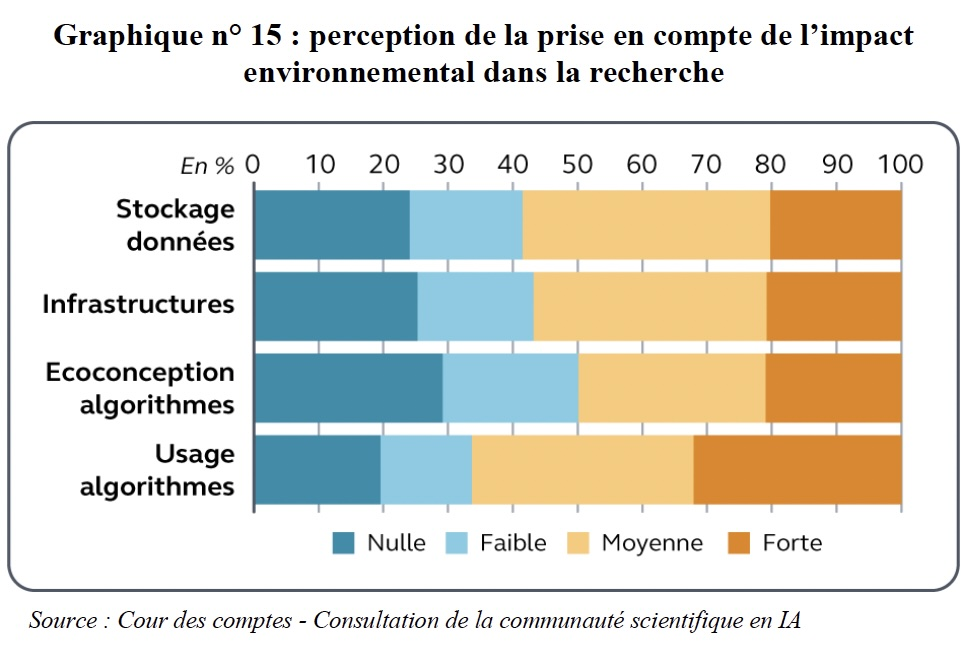Foreword
Artificial Intelligence (AI) systems consume a lot of energy. To operate, they need large computing capacities to train on billions of data sets, which requires powerful servers.
The rise of artificial intelligence has led to such an increase in energy consumption that data centers now use more energy than 92% of the world's countries. Beyond the burden this increase places on power grids, the development of AI also threatens climate objectives.
The quest for a more frugal, more sustainable or more durable AI is guiding a great deal of research and initiatives.
Unlike traditional artificial intelligence models, which are often data- and compute-intensive, and therefore require a lot of electricity and servers, and contribute to warming the environment and the climate, frugal artificial intelligence favors lighter, more efficient approaches.
Frugal AI is now among the four areas to be explored in the second phase of the national artificial intelligence strategy (SNIA), which covers the period 2022-2025, particularly in its research component. The French Ministry of Ecological Transition, for its part, is working to structure a Community of AI Actors in Territories, through a "Call for projects - Frugal AI demonstrators serving the ecological transition in territories". This ministry has also initiated a reference framework to measure and reduce the environmental impact of AI.
Several voices have been raised in recent months to make frugal AI a priority, in France, of the national artificial intelligence strategy:
- In its assessment of the first phase of the SNIA, the Cour des Comptes (French National Audit Office ) sees frugal AI as a "founding principle that should permeate all the research funded by the second phase". However, the challenges of energy and data frugality are " little taken into account in research work", "beyond a few promising initiatives".
- According to the Economic, Social and Environmental Council (CESE) in an opinion issued in September 2024, " there is a concern that funding is lacking for AIs designed directly to protect the environment (...) Research efforts have only marginally focused on frugal AI". The CESE recommends focusing public funding on AI with a direct environmental purpose and on frugal AI.
- The Office parlementaire d'évaluation des choix scientifiques et technologiques (OPECST), for its part, makes the goal of frugal AI an "imperative".
This theme of frugality is on the agenda of the Artificial Intelligence Summit to be held in Paris on February 11 and 12. A coalition for the environmental sustainability of AI could be formed at the end of the Summit.
AI drives energy consumption through the roof
"The conclusion of the Parliamentary Office for the Evaluation of Scientific and Technological Choices (OPECST), in a comprehensive report (339 pages), is that the situation is clear.
"AI requires considerable energy inputs throughout its lifecycle. AI tools, especially generative AI tools that use large language models (LLMs), require a lot of computing power to train their algorithms, and therefore electricity. The AI giants' supercomputers call on tens of thousands of Nvidia chips, even before they are used, just to train the models. While it is estimated that datacenters alone consume less than 2% of the world's electrical energy today, this figure could rise to 4% by the end of the decade under the impact of AI, whose installations require 3 to 5 times more electricity than traditional datacenters."
Most models have to be trained on hundreds or even thousands of graphics processing units( GPUs). These GPUs enable fast matrix calculations, but with proportionately high energy consumption and CO2 production. For example, training GPT-3 on GPUs required 190,000 kWh, or 85,000 kg of CO2 equivalents, equivalent to driving a car 700,000 kilometers, or a round trip from the Earth to the Moon.
According to the International Energy Agency (IEA), global electricity consumption in the AI and datacenter sectors could more than double by 2026 compared to 2022, reaching 1,050 terawatt-hours (TWh), equivalent to Japan's electricity consumption.
This insatiable demand for energy could, according to Gartner, put energy suppliers under pressure and lead to shortages, limiting the growth of new data centers from 2026 onwards.
Référence :
Frugal AI finds its way into the national artificial intelligence strategy
Mathematician, and MP, Cédric Villani in his report on artificial intelligence (AI) questioned the ecological sustainability of AI back in 2018. "It's a question of thinking about a natively ecological AI and using it to better think about the impact of humans on their environment. This is a matter of urgency: by 2040, global storage space requirements, fundamentally correlated with the development of digital technology and AI, are likely to exceed global available silicon production (...) The greening of the AI value chain will necessarily involve open hardware and open software architectures which, in addition to being a confidence-building factor, can enable significant energy savings."
The first phase (2018-2022) of the national artificial intelligence strategy (SNIA) aimed to equip France with competitive research capabilities. The first phase of the SNIA was funded to the tune of 1.5 billion euros. It notably enabled the creation and development of the network of interdisciplinary artificial intelligence institutes (3IA), the establishment of chairs of excellence and doctoral programs, as well as the Jean Zay supercomputer.
In November 2021, a new "acceleration" phase of the SNIA was announced. Frugal AI is among the four priorities of this second phase, along with Embedded AI, Trusted AI, and Generative AI. This second phase, which covers the period 2022-2025 and is endowed with 2.2 billion euros, plans, in particular, to " support 10 frugal AI demonstrator or technological development projects".
Frugal AI is also one of the priorities of the Artificial Intelligence Priority Research Program and Equipment (PEPR), co-piloted by CEA, CNRS and INRIA, with "the ambition of identifying software architectures, frugal learning methodologies for training on controlled databases, and advanced application optimization to rationalize energy consumption of machine learning-based AI systems as far as possible".
Références :
" Frugal AI must permeate all research in a concrete way".
In its first phase, the national AI strategy prioritized research. However, according to the Cour des Comptes, the challenges of energy and data frugality are " little taken into account in research work", "beyond a few promising initiatives". The use of algorithms seems to be the dimension most integrated into research work (see graph below). However, the Cour des Comptes sees frugal AI as a " founding principle a founding principle that should permeate all research funded by the second phase ".

"Many efforts remain to be made in terms of frugal AI and trusted AI, both in terms of mobilizing researchers, allocating resources and the indispensable construction of a European normative framework," concludes the Cour des Comptes. "In order to ensure that frugal AI development objectives are met in the second phase, whatever the sector, it would be advisable to improve the measurement and monitoring of the ecological footprint of AI, and to build a framework of actions compatible with the control of the environmental footprint."
Référence :
"Concentrate funding on AI with a direct environmental purpose and on frugal AI".
The French Economic, Social and Environmental Council (CESE), for its part, in an opinion issued in September 2024, observes that " AI is currently used mainly in areas such as finance, targeted marketing and now industry, and not to train and operate optimization algorithms that benefit the environment (...) Under these conditions, it is to be feared that funding will be lacking for AI designed directly to protect the environment".
Six years after the Villani report, we have to admit that research efforts have only marginally focused on "frugal AI". While the Artificial Intelligence and Ecological Transition Roadmappublished in 2021 (by the French Ministry of Ecological Transition) includes a "frugality" section, there are still too few projects underway".
According to the CESE, frugal AI could be a priority focus of the fourth Future Investment Program 2021-2026 and the France 2030 investment plan.
The EESC recommends focusing public funding on AI with a direct environmental purpose and on frugal AI.
- A systematic assessment of the environmental footprint of AIs will have to be carried out, requiring the companies concerned to be transparent about resource consumption, and building an evaluation benchmark. Such an AI "Ecoscore" will enable users, citizens and companies alike, to choose the most sober AIs (recommendation no. 5).
- At the same time, engineers will have to become more involved in the eco-design of equipment, particularly terminals, the renewal of which is accelerated by AI (recommendation no. 6), and users can be made more aware of their responsibilities through information campaigns on the environmental footprint of AI and the possibility, currently non-existent, of disconnecting AI uses and data collection on their applications (recommendation no. 7).
- Last but not least, measures are immediately applicable to data centers. For data center projects, the public authorities must ensure compliance with the objective of zero net artificialisation, in particular by using sites that have already been artificialised (recommendation no. 8), the European sustainability rating system for these centers must be taken into account, and the principle of recovering waste heat must be integrated (recommendation no. 9).
Référence :
12 frugal AI demonstrators in the regions
As part of its "AI and ecological transition" roadmap, the French Ministry of Ecological Transition has been supporting frugal AI-based solutions for territories since 2022.
The " Démonstrateurs d'AI frugale des territoires" (DIAT) call for projects targeted AI projects capable of making predictions and recommendations to aid decision-making. " AI solutions must be frugal in terms of data and energy, and their own environmental impact must be measured, which must be thought out upstream of project construction ".
12 projects were selected for this call for projects. The Banque ds territoires, operator of the call for projects, has identified three approaches to frugality among the selected projects:
- Minimize data collection, aiming for quality rather than quantity, and ensuring that only the data needed for the purpose is updated". This was notably the case for the IA.rbre project, which uses AI to help the Lyon metropolitan area detect "plantable" areas and use vegetation to create cooling zones or combat runoff phenomena.
- Limiting the number of sensors: frugality can also be achieved by exploiting data that are not originally environmental data. Through the Predict AI'r project run by the Paris-Ouest La Défense public establishment, the consortium will exploit cell phone boundary data to deduce, using AI, users' travel patterns and their impact on air quality. A strategy that could make it possible to avoid multiplying the number of air sensors, while at the same time being applicable to any territory, in France and worldwide.
- Frugality can also be measured by the positive externalities that AI generates in organizations. In Saclay, for example, the Urba (IA) project supported by the agglomeration community promises to help local authorities in the Paris region revise their local urban planning schemes (PLU) by integrating all normative constraints in terms of environmental protection, whether regional or national.
These calls for projects are enabling the Ministry of Ecological Transition to bring together a Community of AI Actors in Territories (CAIAT) made up of representatives of territories, competitiveness clusters, research institutions, VSEs/startups/SMEs and companies.
Références :
A benchmark for measuring and reducing the environmental impact of AI
The Ecolab of the Commissariat Général au Développement Durable (CGDD) and the Association Française de Normalisation (AFNOR) have published a methodology for assessing the effect of an AI service on the environment. In addition to providing an initial operational reference framework for quantifying its impact, the document contains a set of best practices to adopt in moving towards frugal AI.
The method has been developed using a global approach, i.e. it covers all the digital resources mobilized to deliver the service. Starting with data centers (servers, storage bays, network equipment), which host and process digital data. Next come the network infrastructures that ensure data transmission to users. And finally, the terminals (smartphones, computers, televisions, etc.) that operate, receive and consult content.
- The entire lifecycle of a system is taken into account, from design to development to commissioning. This implies a reflection on the very necessity of using AI versus less resource-intensive solutions. AI must not become a systematic response to every need.
- Frugality also means minimizing the material and energy resources mobilized to create the AI system. This includes rationalizing AI models, reducing the volume of data used to train them, and optimizing the infrastructures they mobilize, such as data centers. The compression of algorithms and the use of open source data are also encouraged to reduce their carbon footprint.
- Throughout the AI lifecycle, the standard then requires measurement of the direct impact of the AI (energy consumed, CO2 emitted, resources consumed) as well as its indirect effects, such as the rebound effect, where an improvement in efficiency can lead to an increase in consumption.
- Finally, clear governance must be put in place to ensure that frugality principles are integrated into every stage of an AI project. AI suppliers and producers must communicate transparently on the actions implemented to limit impacts, providing precise assessments and clear methodologies.
Références :
Sources
1. ChatGPT, what's next? Review and outlook for artificial intelligence
2. Villani report: The AI strategy, to make France a major player in artificial intelligence (2018)
3. With France 2030, France positions AI as a gas pedal and differentiator of innovation (May 2024)
4. France 2030: national strategy for artificial intelligence (September 2024)
6. CESE, Impacts of artificial intelligence: risks and opportunities for the environment
12. A benchmark for measuring and reducing the environmental impact of AI





